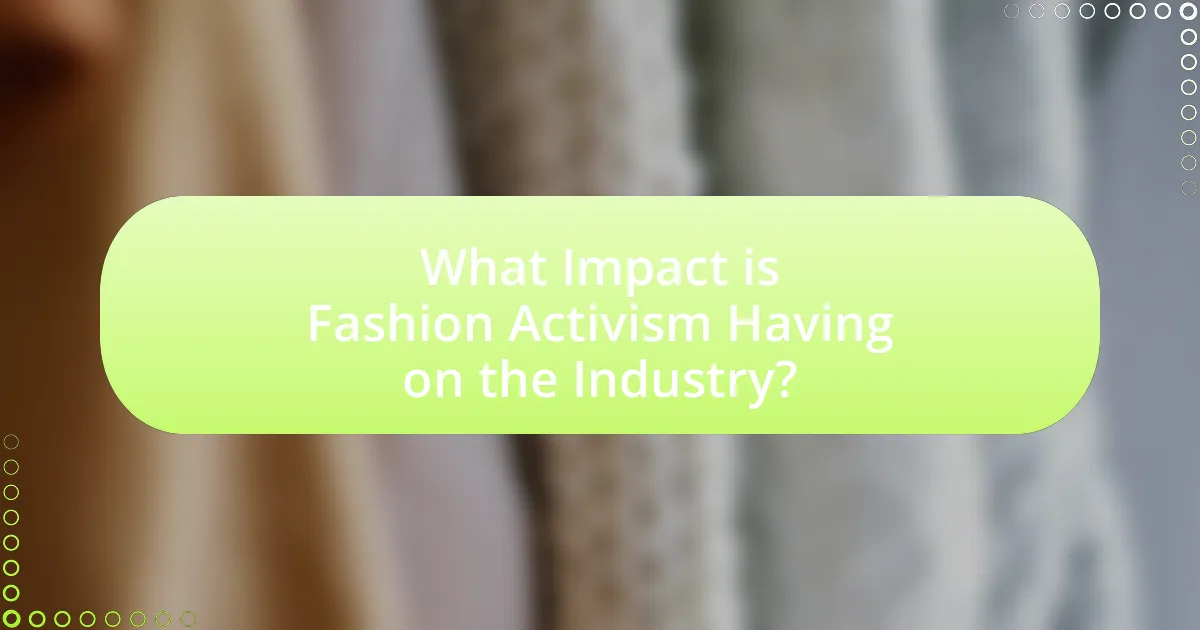Fashion activism is a movement within the fashion industry where designers and consumers advocate for sustainable practices to address environmental issues such as waste, pollution, and unethical labor. The article explores how designers engage in fashion activism by creating sustainable collections, promoting ethical labor practices, and raising awareness about environmental issues. Key principles of fashion activism include sustainability, ethical production, and social justice, which collectively aim to foster a more responsible fashion industry. The article also examines the impact of consumer behavior on environmental change, the strategies designers use for advocacy, and the challenges faced in promoting sustainable practices. Additionally, it highlights the role of education and regulatory frameworks in supporting fashion activism and provides practical tips for consumers to make more sustainable fashion choices.

What is Fashion Activism and its Role in Environmental Change?
Fashion activism is a movement where designers and consumers advocate for sustainable practices within the fashion industry to combat environmental degradation. This activism addresses issues such as waste, pollution, and unethical labor practices by promoting eco-friendly materials, ethical production methods, and circular fashion concepts. For instance, the Ellen MacArthur Foundation reports that the fashion industry is responsible for 10% of global carbon emissions, highlighting the urgent need for change. By raising awareness and implementing sustainable practices, fashion activism plays a crucial role in driving environmental change and encouraging a shift towards a more responsible industry.
How do designers engage in fashion activism?
Designers engage in fashion activism by creating sustainable collections, promoting ethical labor practices, and raising awareness about environmental issues through their work. For instance, many designers utilize eco-friendly materials and processes to minimize their carbon footprint, such as Stella McCartney, who is known for her commitment to sustainable fashion. Additionally, designers often collaborate with non-profit organizations to advocate for social justice and environmental protection, exemplified by brands like Patagonia, which donates a portion of its profits to environmental causes. This approach not only influences consumer behavior but also encourages industry-wide changes towards more responsible practices.
What are the key principles of fashion activism?
The key principles of fashion activism include sustainability, ethical production, and social justice. Sustainability emphasizes the use of eco-friendly materials and practices to minimize environmental impact, as seen in brands that prioritize organic fabrics and reduced waste. Ethical production focuses on fair labor practices, ensuring that workers are treated justly and compensated fairly, which is critical in combating exploitation in the fashion industry. Social justice advocates for inclusivity and diversity, pushing for representation across all demographics in fashion narratives. These principles collectively aim to create a more responsible and equitable fashion industry, addressing both environmental and social issues.
How does fashion activism differ from traditional activism?
Fashion activism differs from traditional activism primarily in its medium and approach; it utilizes clothing and fashion as tools for social and environmental change. While traditional activism often relies on protests, lobbying, and policy advocacy, fashion activism engages consumers through the aesthetic and cultural significance of clothing, promoting awareness and action on issues like sustainability and ethical production. For example, brands like Patagonia have integrated environmental messages into their marketing and product designs, effectively merging consumerism with activism. This approach not only raises awareness but also encourages consumers to make conscious purchasing decisions, thereby influencing industry practices directly.
Why is environmental change a critical issue in the fashion industry?
Environmental change is a critical issue in the fashion industry due to its significant contribution to pollution and resource depletion. The fashion sector is responsible for approximately 10% of global carbon emissions and is a major consumer of water, with the production of a single cotton t-shirt requiring around 2,700 liters of water. Additionally, the industry generates substantial waste, with an estimated 92 million tons of textile waste produced annually. These factors highlight the urgent need for sustainable practices and environmental advocacy within the industry to mitigate its impact on climate change and natural resources.
What are the environmental impacts of fast fashion?
Fast fashion significantly contributes to environmental degradation through excessive resource consumption, pollution, and waste generation. The production of fast fashion garments requires vast amounts of water; for instance, it takes approximately 2,700 liters of water to produce a single cotton t-shirt. Additionally, the fast fashion industry is responsible for about 10% of global carbon emissions, which is more than the emissions from international flights and maritime shipping combined. Furthermore, the disposal of fast fashion items leads to massive amounts of textile waste, with an estimated 92 million tons of textiles discarded annually, much of which ends up in landfills. These impacts highlight the urgent need for sustainable practices in the fashion industry.
How does consumer behavior influence environmental change in fashion?
Consumer behavior significantly influences environmental change in fashion by driving demand for sustainable practices and products. When consumers prioritize eco-friendly materials and ethical production, brands are compelled to adapt their practices to meet these expectations. For instance, a 2021 survey by McKinsey & Company found that 67% of consumers consider the use of sustainable materials important when making fashion purchases. This shift in consumer preferences encourages brands to invest in sustainable technologies and supply chains, ultimately leading to reduced environmental impact.

What Strategies are Designers Using for Environmental Advocacy?
Designers are employing various strategies for environmental advocacy, including sustainable material sourcing, upcycling, and promoting circular fashion. Sustainable material sourcing involves selecting eco-friendly fabrics that reduce environmental impact, such as organic cotton or recycled polyester. Upcycling transforms waste materials into new products, minimizing landfill contributions and resource consumption. Promoting circular fashion encourages consumers to buy less and invest in quality items that can be reused or recycled, thereby extending the lifecycle of garments. These strategies are supported by industry reports indicating that sustainable practices can significantly reduce carbon footprints and resource depletion in fashion.
How are sustainable materials being integrated into fashion design?
Sustainable materials are being integrated into fashion design through the use of organic textiles, recycled fabrics, and innovative bio-based materials. Designers are increasingly opting for organic cotton, hemp, and Tencel, which reduce environmental impact by minimizing pesticide use and water consumption. Additionally, brands are incorporating recycled polyester and nylon, derived from post-consumer waste, to decrease reliance on virgin resources. Research indicates that the global market for sustainable fashion is projected to reach $8.25 billion by 2023, highlighting the growing consumer demand for eco-friendly options. This shift not only addresses environmental concerns but also promotes ethical labor practices within the industry.
What types of sustainable materials are most commonly used?
Sustainable materials commonly used in fashion include organic cotton, Tencel, hemp, recycled polyester, and bamboo. Organic cotton is grown without synthetic pesticides or fertilizers, reducing environmental impact. Tencel, made from sustainably sourced wood pulp, is biodegradable and produced in a closed-loop process that minimizes waste. Hemp requires less water and no pesticides, making it an eco-friendly option. Recycled polyester, derived from post-consumer plastic bottles, helps reduce landfill waste and conserves resources. Bamboo grows rapidly and requires minimal water, making it a sustainable choice. These materials are increasingly favored by designers committed to environmental change in the fashion industry.
How do these materials contribute to environmental change?
Materials used in fashion contribute to environmental change primarily through their production processes, which often involve significant resource consumption and pollution. For instance, conventional cotton farming requires large amounts of water and pesticides, leading to soil degradation and water scarcity. Additionally, synthetic materials like polyester are derived from petroleum, contributing to greenhouse gas emissions during extraction and production. According to the Ellen MacArthur Foundation, the fashion industry is responsible for 10% of global carbon emissions, highlighting the substantial impact of these materials on climate change.
What role does education play in fashion activism?
Education plays a crucial role in fashion activism by equipping individuals with the knowledge and skills necessary to advocate for sustainable practices within the industry. It fosters awareness about the environmental and social impacts of fashion, encouraging consumers and designers alike to make informed choices. For instance, educational programs that focus on sustainable design principles and ethical sourcing empower future designers to create environmentally friendly collections. Research indicates that 66% of consumers are willing to pay more for sustainable brands, highlighting the importance of educating the public about the benefits of sustainable fashion. Thus, education not only informs but also drives the demand for change in the fashion industry.
How are designers educating consumers about sustainability?
Designers are educating consumers about sustainability through transparent communication about materials and production processes. By sharing information on eco-friendly materials, such as organic cotton or recycled polyester, designers help consumers understand the environmental impact of their choices. For instance, brands like Stella McCartney emphasize sustainable practices in their marketing, showcasing their commitment to reducing waste and carbon footprints. Additionally, many designers host workshops and events that focus on sustainable fashion, allowing consumers to engage directly with the concepts and practices of eco-conscious design. This hands-on approach fosters a deeper understanding of sustainability in the fashion industry.
What initiatives are in place to promote awareness of environmental issues?
Initiatives promoting awareness of environmental issues include campaigns by fashion brands that focus on sustainability and eco-friendly practices. For example, organizations like Fashion Revolution advocate for transparency in the fashion supply chain, encouraging consumers to ask brands “Who made my clothes?” This initiative raises awareness about labor practices and environmental impacts. Additionally, events such as Earth Day and initiatives like the Sustainable Fashion Forum bring together designers, consumers, and activists to discuss and promote sustainable practices in the fashion industry. These efforts collectively aim to educate the public on the environmental consequences of fashion and inspire more responsible consumer behavior.

What Impact is Fashion Activism Having on the Industry?
Fashion activism is significantly reshaping the fashion industry by promoting sustainable practices and ethical production. Designers are increasingly advocating for environmental change, leading to a rise in eco-friendly materials and transparent supply chains. For instance, brands like Stella McCartney and Patagonia have pioneered the use of recycled materials and have committed to reducing their carbon footprints. This shift not only influences consumer behavior, as more shoppers prefer sustainable options, but also pressures other companies to adopt similar practices to remain competitive. According to a 2021 McKinsey report, 67% of consumers consider sustainability when making a purchase, highlighting the growing impact of fashion activism on market trends and corporate responsibility.
How are brands responding to the call for environmental change?
Brands are increasingly adopting sustainable practices to respond to the call for environmental change. Many fashion companies are implementing eco-friendly materials, such as organic cotton and recycled polyester, to reduce their carbon footprint. For instance, brands like Stella McCartney and Patagonia have committed to using sustainable fabrics and promoting circular fashion, which encourages recycling and reusing garments. Additionally, a report by McKinsey & Company indicates that 67% of consumers consider sustainability when making purchasing decisions, prompting brands to prioritize environmental responsibility in their business models. This shift not only addresses consumer demand but also aligns with global initiatives aimed at combating climate change.
What are some examples of brands leading the way in fashion activism?
Brands leading the way in fashion activism include Patagonia, Stella McCartney, and Reformation. Patagonia is renowned for its commitment to environmental sustainability, pledging 1% of sales to environmental causes and promoting fair labor practices. Stella McCartney emphasizes cruelty-free fashion and sustainable materials, being a pioneer in eco-friendly luxury. Reformation focuses on transparency in its supply chain and uses sustainable fabrics, aiming to reduce its carbon footprint. These brands exemplify how the fashion industry can advocate for environmental change through responsible practices and activism.
How do these brands measure their impact on the environment?
Brands measure their impact on the environment through various metrics, including carbon footprint assessments, water usage tracking, and waste management evaluations. For instance, many fashion brands utilize life cycle assessments (LCAs) to quantify the environmental impacts of their products from raw material extraction to disposal. These assessments provide data on greenhouse gas emissions, energy consumption, and resource depletion. Additionally, brands often report sustainability metrics in their annual sustainability reports, which may include specific targets for reducing emissions or waste. For example, a brand might commit to reducing its carbon emissions by 50% by 2030, demonstrating a measurable goal aligned with environmental impact reduction.
What challenges do designers face in advocating for environmental change?
Designers face significant challenges in advocating for environmental change, primarily due to the tension between consumer demand for fast fashion and sustainable practices. This conflict is exacerbated by the industry’s reliance on low-cost production methods, which often prioritize profit over environmental considerations. Additionally, designers encounter obstacles such as limited access to sustainable materials, which can be more expensive and harder to source compared to conventional options. Research indicates that 92 million tons of textile waste are generated annually, highlighting the urgency for change but also the resistance within the industry to adopt more sustainable practices. Furthermore, designers often struggle to communicate the importance of sustainability to consumers who may prioritize style and affordability over environmental impact.
What are the economic implications of sustainable fashion practices?
Sustainable fashion practices have significant economic implications, including the potential for job creation and increased market demand for eco-friendly products. By prioritizing sustainable materials and ethical production methods, the fashion industry can stimulate local economies and create new employment opportunities in sectors such as organic farming, recycling, and sustainable manufacturing. For instance, a report by the Global Fashion Agenda indicates that transitioning to sustainable practices could generate up to 1.5 million new jobs by 2030. Additionally, consumers are increasingly willing to pay a premium for sustainable products, with a Nielsen survey showing that 66% of global consumers are willing to spend more on sustainable brands. This shift in consumer behavior can drive revenue growth for companies that adopt sustainable practices, ultimately leading to a more resilient and responsible fashion industry.
How do regulatory frameworks affect fashion activism?
Regulatory frameworks significantly influence fashion activism by establishing guidelines that promote sustainable practices and ethical standards within the industry. These frameworks, such as the European Union’s Green Deal and various national environmental regulations, compel fashion brands to adopt eco-friendly materials and reduce waste, thereby aligning their operations with activist goals. For instance, the EU’s Circular Economy Action Plan encourages the use of recycled materials and aims to minimize textile waste, directly impacting how designers approach sustainability in their collections. Consequently, regulatory measures not only drive compliance but also empower activists by creating a structured environment where sustainable fashion can thrive.
What can consumers do to support fashion activism?
Consumers can support fashion activism by choosing to purchase from sustainable and ethical brands. By selecting companies that prioritize environmentally friendly practices, such as using organic materials and fair labor conditions, consumers directly contribute to reducing the fashion industry’s negative impact on the environment. Research indicates that the global sustainable fashion market is projected to reach $8.25 billion by 2023, highlighting a growing consumer demand for responsible fashion choices. Additionally, consumers can advocate for change by participating in campaigns, sharing information on social media, and supporting legislation that promotes sustainability in the fashion industry.
How can consumers make more sustainable fashion choices?
Consumers can make more sustainable fashion choices by prioritizing brands that use eco-friendly materials and ethical production practices. Research indicates that the fashion industry is responsible for 10% of global carbon emissions, highlighting the importance of selecting sustainable options. By choosing clothing made from organic cotton, recycled materials, or sustainable fabrics like Tencel, consumers can reduce their environmental impact. Additionally, supporting brands that are transparent about their supply chains and labor practices ensures that ethical standards are upheld. Engaging in second-hand shopping or clothing swaps further minimizes waste, as it extends the lifecycle of garments.
What are some practical tips for supporting eco-friendly brands?
To support eco-friendly brands, consumers should prioritize purchasing from companies that demonstrate sustainable practices, such as using organic materials and ethical labor. Research indicates that brands like Patagonia and Eileen Fisher have committed to transparency in their supply chains and utilize recycled materials, which enhances their eco-friendly credentials. Additionally, consumers can engage with these brands by sharing their values on social media, thereby amplifying their message and encouraging others to make sustainable choices. Supporting local eco-friendly brands also reduces carbon footprints associated with transportation, further contributing to environmental sustainability.
